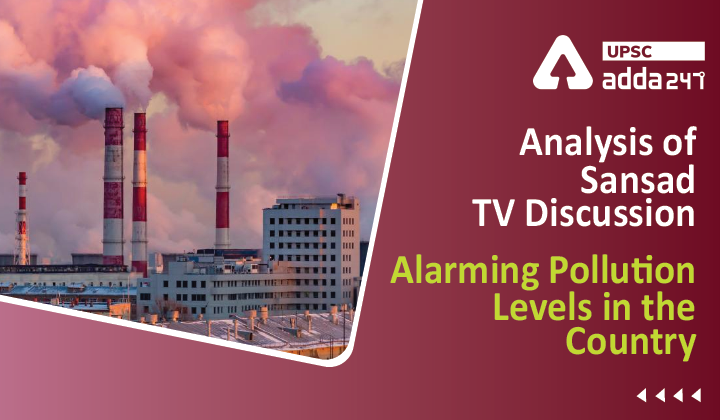Table of Contents
Analysis Of Sansad TV Discussion: ”Alarming Pollution Levels in the Country”
Relevance
GS 3: Environmental Pollution & Degradation
Introduction
- According to the World Air Quality Report released by IQAir, a Swiss firm on March 22, India is the fifth most polluted country among 117 countries, regions and territories around the world,
- According to the Report, New Delhi is the world’s most polluted capital.
- India is fifth in the most polluted country category preceded by Bangladesh, Chad, Pakistan and Tajikistan.
- 11 of the 15 most polluted cities in Central and South Asia in 2021 are in India.
What proved India a Pollution Capital?
- The country’s annual average PM2.5 levels reached 58.1 micrograms per cubic meter (µg/m3) in 2021, returning to pre-quarantine concentrations measured in 2019.
- The WHO recommends that average annual readings of small and hazardous airborne particles known as PM2.5 should be no more than 5 micrograms per cubic meter after changing its guidelines in 2021.
Why Does The Report Assess Only PM2.5?
- Particulate Matter (PM) 2.5 consisting of fine aerosol particles measuring 2.5 microns or smaller in diameter, is one of six routinely measured criteria air pollutants and is commonly accepted as the most harmful to human health due to its prevalence in the environment and a broad range of health effects.
- The latest report is based on PM2.5 air quality data from 6,475 cities in 117 countries, regions, and territories around the world.
- The data used to create this report was generated by tens of thousands of regulatory and low-cost air quality monitoring stations operated by governments, non-profit organizations, research institutions, educational facilities, companies, and citizen scientists around the world.
Worldwide Scenario
- The report revealed that not a single country managed to meet the WHO’s air quality standard in 2021, and smog even rebounded in some regions after a Covid-related dip in numbers.
- WHO’s guidelines of September 2021 warrant good air quality with PM2.5 concentration level between 0-5 g/m3. However, all these cities have ultra-fine particulate matter (PM)2.5 levels at least 10 times more than the approved limits.
Why is air pollution a cause for concern?
- According to the report’s executive summary, air pollution is now considered to be the world’s largest environmental health threat, accounting for seven million deaths around the world every year.
- Air pollution causes and aggravates many diseases, ranging from asthma to cancer, lung illnesses and heart disease.
- The estimated daily economic cost of air pollution has been figured at $8 billion (USD), or 3 to 4 per cent of the gross world product.
- We are increasingly seeing a number of patients develop an acute allergic reaction to these air pollutants resulting in worsening of the existing respiratory illnesses such as asthma or allergies.
- A large number of patients who have been exposed to such pollutants present with breathlessness and/or cough actually turn out to have hypersensitivity pneumonitis which is potentially reversible if detected & treated early.
- However, if the patient presents late it may even result in lung fibrosis.
What need to be done?
- In India, major sources of air pollution include vehicular emissions, power generation, industrial waste, biomass combustion for cooking, the construction sector, and episodic events like crop burning.
- The UN Intergovernmental Panel on Climate Change also concluded in its 2021 report that in addition to slowing the speed of global warming, curbing the use of fossil fuels would help improve air quality and public health.
- So, India need to move forward in that direction.



 TSPSC Group 1 Question Paper 2024, Downl...
TSPSC Group 1 Question Paper 2024, Downl...
 TSPSC Group 1 Answer key 2024 Out, Downl...
TSPSC Group 1 Answer key 2024 Out, Downl...
 UPSC Prelims 2024 Question Paper, Downlo...
UPSC Prelims 2024 Question Paper, Downlo...





